In-Situ Damage Evaluation of Pure Ice under High Rate Compressive Loading
Abstract
:1. Introduction
2. Experimental Methods
2.1. Preparation of Specimens
2.2. High Strain Rate Testing with the Split Hopkinson Pressure Bar
2.3. Data analysis of Dynamic Tests on Ice
2.4. Quasi-Static Tests
3. Results
4. Discussion
5. Conclusions
- Under high rate loading damage may initiate and propagate in the specimen even before the peak load is reached. Catastrophic damage only occurs after the peak load was reached.
- Under high rate loading the damage was observed to propagate in the specimen with a rate, which is in the same order of magnitude as the velocity of the elastic loading wave in ice.
- The above-mentioned findings lead to the conclusion that a state of full force equilibrium is not ensured in the specimen when damage initiates and propagates. This finding implies that already at this loading rate the determination of the strength of ice is affected by wave propagation effects. The force equilibrium can theoretically be improved by replacing the aluminum bars with bars matching the impedance of ice more closely. Amongst practical engineering materials, the next option after aluminum would be a technical polymer. However, this approach is believed to bring about more problems than solutions in the current case: The bars would be deforming visco-elastically, thus demanding tedious numerical techniques and experimental calibration in order to accurately interpret the strain gauge signals in the presence of notable dispersion and frequency-dependent damping in the wave motion. In the current study this would be exceptionally challenging due to the short duration of the tests and brittle response of the specimen, which would inevitably lead to notable distortion of the stress waves, as they travel in visco-elastic bars. Furthermore, the mechanical properties of the visco-elastic polymer bars would be most likely affected, when they are subjected to sub-zero temperature in the specimen cooling chamber.
- The fractured specimen can carry notable load when it is compressed at 10 m/s, but not when it is compressed at 0.05 mm/s. This can be explained by dynamic effects which do not occur under quasi-static loading conditions which are four orders of magnitude smaller than the high-rate loading conditions achieved using the Hopkinson Bar apparatus.
- For quasi-static loading, the measured engineering mean peak stress was 15.6 MPa (COV 31.6%), for high-rate loading, the measured engineering mean peak stress was 12.4 MPa (COV 34.1%) indicating a decrease of strength with increasing loading rate. However, at the same time, the post failure response changes with loading rate such that the post-peak load carrying capability is higher for high loading rates. However, due to the small sample size, this lacks stochastic relevance and should be assessed with more tests.
Supplementary Materials
Author Contributions
Funding
Conflicts of Interest
Appendix A





References
- Hail Threat Standardization FINAL Report for EASA.2009.OP.25; European Aviation Safety Agency: Cologne, Germany, 2010.
- Carney, K.S.; Benson, D.J.; DuBois, P.M.; Lee, R. A phenomenological high strain rate model with failure for ice. Int. J. Solids Struct. 2006, 43, 7820–7839. [Google Scholar] [CrossRef]
- Tippman, J.D.; Kim, H.; Rhymer, J.D. Experimentally validated strain rate dependent material model for spherical ice impact simulation. Int. J. Impact Eng. 2013, 57, 43–54. [Google Scholar] [CrossRef]
- Shazly, M.; Prakash, V.; Lerch, B.A. High strain-rate behavior of ice under uniaxial compression. Int. J. Solids Struct. 2009, 46, 1499–1515. [Google Scholar] [CrossRef]
- Kim, H.; Keune, J.N. Compressive strength of ice at impact strain rates. J. Mater. Sci. 2007, 42, 2802–2806. [Google Scholar] [CrossRef]
- Bragov, A.; Igumnov, L.; Konstantinov, A.; Lomunov, A.; Filippov, A.; Shmotin, Y.; Didenko, R.; Krundaeva, A. Investigation of strength properties of freshwater ice. EPJ Web Conf. 2015, 94, 01070. [Google Scholar] [CrossRef]
- Wu, X.; Prakash, V. Dynamic compressive behavior of ice at cryogenic temperatures. Cold Reg. Sci. Technol. 2015, 118, 1–13. [Google Scholar] [CrossRef]
- Song, Z.; Wang, Z.; Kim, H.; Ma, H. Pulse Shaper and Dynamic Compressive Property Investigation on Ice Using a Large-Sized Modified Split Hopkinson Pressure Bar. Lat. Am. J. Solids Stru. 2016, 13, 391–406. [Google Scholar] [CrossRef]
- Chen, W.; Song, B. Split Hopkinson (Kolsky) Bar – Design, Testing and Applications; Springer Science+Business Media: New York, NY, USA, 2011. [Google Scholar]
- Lian, J.; Ouyang, Q.; Zhao, X.; Liu, F.; Qi, C. Uniaxial Compressive Strength and Fracture of Lake Ice at Moderate Strain Rates Based on a Digital Speckle Correlation Method for Deformation Measurements. Appl. Sci. 2017, 7, 495. [Google Scholar] [CrossRef]
- Petrovic, J.J. Review Mechanical properties of ice and snow Compressive strength of ice at impact strain rates. J. Mater. Sci. 2003, 38, 1–6. [Google Scholar] [CrossRef]
- Pereira, J.M.; Padula, S.A.; Revilock, D.M.; Melis, M.E. Forces Generated by High Velocity Impact of ice on a Rigid Structure; BiblioGov: London, UK, 2013. [Google Scholar]
- Smith, A.C.; Kishoni, D. Measurement of the Speed of Sound in Ice. AIAA J. 1986, 24, 1713–1715. [Google Scholar] [CrossRef]










© 2019 by the authors. Licensee MDPI, Basel, Switzerland. This article is an open access article distributed under the terms and conditions of the Creative Commons Attribution (CC BY) license (http://creativecommons.org/licenses/by/4.0/).
Share and Cite
Isakov, M.; Lange, J.; Kilchert, S.; May, M. In-Situ Damage Evaluation of Pure Ice under High Rate Compressive Loading. Materials 2019, 12, 1236. https://doi.org/10.3390/ma12081236
Isakov M, Lange J, Kilchert S, May M. In-Situ Damage Evaluation of Pure Ice under High Rate Compressive Loading. Materials. 2019; 12(8):1236. https://doi.org/10.3390/ma12081236
Chicago/Turabian StyleIsakov, Matti, Janin Lange, Sebastian Kilchert, and Michael May. 2019. "In-Situ Damage Evaluation of Pure Ice under High Rate Compressive Loading" Materials 12, no. 8: 1236. https://doi.org/10.3390/ma12081236
APA StyleIsakov, M., Lange, J., Kilchert, S., & May, M. (2019). In-Situ Damage Evaluation of Pure Ice under High Rate Compressive Loading. Materials, 12(8), 1236. https://doi.org/10.3390/ma12081236




